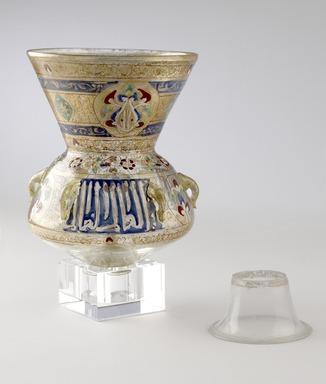Arts of the Islamic World: Mosque Lamp
| Domes of the Mamluk (900-1300) |
To add some background, the medieval period was the crusades, from 900 to the 1300s. This is also known as a military struggle. There were peaceful exchanges between the west and the east of goods and ideas. Christians and Islamic had undergone great transformations.
Mamluk ruling from 1250 to 1517 which was the 13th and 14th century. The name was given by historians later in time. Mamluk means “owned” in Arabic. This refers to Turkic slaves who served as soldiers for the Ayyubid sultanate before revolting and rising to power. Mamluks rule over lands in the Middle East such as Mecca and Medina.
Mamluk capital at Cairo became the artistic and economic center of the Islamic world during this time. They had a great production of art and agriculture during this period, usually sold by reigning sultans. Sponsoring the arts and creating monumental structures was a way for the leaders to display their wealth to the public and made it very visible to the city.
The Mosque Lamp was a beautiful mosque piece that not only had an illuminated glow, but symbolism. It symbolizes divine light and by extension the presence of God. This piece in particular is the most characteristic type. It has a flared neck, it has a rounded body, as well as six handles, and a wide foot. The colors were marvelously blended into colorless glass. There were blue, red, green, yellow, gold, and white enamels. This piece was free blown, applied, and gilded. It also had an Arabic inscription that was written in three places.
 |
| Mosque lamp, Syria, 13th-14th century (Brooklyn Museum) |
The Mamluks created numerous mosques, madrasa, and mausolea that were excessively furnished and decorated. Sadly, in 1517 the Mamluk sultanate was taken over and captivated into the developing Ottoman Empire.
Cite this page as: Glenna Barlow, "Arts of the Islamic world: The medieval period," in Smarthistory, August 8, 2015, accessed September 23, 2020, https://smarthistory.org/arts-of-the-islamic-world-the-medieval-period/.
Yalman, Suzan. “The Art of the Mamluk Period (1250–1517).” In Heilbrunn Timeline of Art History. New York: The Metropolitan Museum of Art, 2000–. http://www.metmuseum.org/toah/hd/maml/hd_maml.htm (October 2001)
Carboni, Stefano, and Qamar Adamjee. “Enameled and Gilded Glass from Islamic Lands.” In Heilbrunn Timeline of Art History. New York: The Metropolitan Museum of Art, 2000–. http://www.metmuseum.org/toah/hd/enag/hd_enag.htm (October 2002)
Hi Chloe!
ReplyDeleteI really enjoyed reading your blog-post, I too did a post on the Mamluk sultanate. I found it very interesting that this was one of the first societies that had slaves active in government. I didn't know that they saw lamps such as these as an extension of divine light, very interesting. My only critique would be to bring it back to why this is important for us to know, there are historical objects everywhere that aren't in museums because of their viewed 'lack of' significance to a culture, so why is this one viewed significant (besides it's religious importance). Other than that, great blog post!